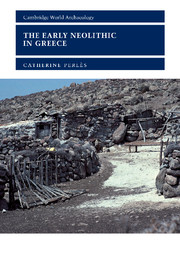Book contents
- Frontmatter
- Contents
- List of figures
- List of tables
- Acknowledgements
- Introduction
- 1 The land and its resources: the geographic context
- 2 The Mesolithic background
- 3 The introduction of farming: local processes, diffusion or colonization?
- 4 Foreign colonists: where from?
- 5 The earliest Neolithic deposits: ‘aceramic’, ‘pre-pottery’ or ‘ceramic’?
- 6 The spread of the Early Neolithic in Greece: chronological and geographical aspects
- 7 A case study in Early Neolithic settlement patterns: eastern Thessaly
- 8 Early Neolithic subsistence economy: the domestic and the wild
- 9 The Early Neolithic village
- 10 Craft specialization: the contrasting cases of chipped-stone tools, pottery and ornaments
- 11 A variety of daily crafts
- 12 Ritual interaction? The miniature world of ‘dolls or deities’
- 13 Interacting with the dead: from the disposal of the body to funerary rituals
- 14 Interactions among the living
- Conclusion
- Bibliography
- Index
12 - Ritual interaction? The miniature world of ‘dolls or deities’
Published online by Cambridge University Press: 18 December 2009
- Frontmatter
- Contents
- List of figures
- List of tables
- Acknowledgements
- Introduction
- 1 The land and its resources: the geographic context
- 2 The Mesolithic background
- 3 The introduction of farming: local processes, diffusion or colonization?
- 4 Foreign colonists: where from?
- 5 The earliest Neolithic deposits: ‘aceramic’, ‘pre-pottery’ or ‘ceramic’?
- 6 The spread of the Early Neolithic in Greece: chronological and geographical aspects
- 7 A case study in Early Neolithic settlement patterns: eastern Thessaly
- 8 Early Neolithic subsistence economy: the domestic and the wild
- 9 The Early Neolithic village
- 10 Craft specialization: the contrasting cases of chipped-stone tools, pottery and ornaments
- 11 A variety of daily crafts
- 12 Ritual interaction? The miniature world of ‘dolls or deities’
- 13 Interacting with the dead: from the disposal of the body to funerary rituals
- 14 Interactions among the living
- Conclusion
- Bibliography
- Index
Summary
According to some recent essays on the Neolithic, the latter should be viewed primarily as a mental, symbolic mutation: a new conception of the supernatural world, a different way of interacting with ‘divinities’ (Cauvin 1997; Hodder 1990). Whether or not this ‘symbolic revolution’ is considered as a driving force, it cannot be denied that the technical, economic and social transformations were sustained by transformations in the symbolic and ritual domains. The latter are often expressed in spectacular ways: the early PPNB monumental buildings such as the ‘Skull building’ at Çayönü (Özdoğan and Özdoğan 1990), the ‘temples’ with greater than life-size anthropomorphic pillars at Nevali Çori (Hauptmann 1993), the 8-metre high tower of Jericho (Kenyon 1957). These early collective monuments are echoed, in later contexts, by the equally monumental graves and megalithic buildings of the Atlantic façade. In parallel, the highly structured representations on the house walls at Çatal Hüyük demonstrate that this ‘symbolic revolution’, whatever its exact interpretation (e.g., Cauvin 1997; Forest 1993; Hodder 1990), had also penetrated within the more private, domestic sphere.
Yet, no equivalent of these spectacular symbolic expressions has thus far been found in the Neolithic of Greece. If a spiritual mutation is to be recognized, it can possibly be sought in the profusion of small, ‘non-utilitarian’ objects – miniatures, models, ornaments, precious stone artefacts, incised clay tablets, and so forth – that characterize the Neolithic of Greece and that of its Near Eastern and Balkanic counterparts.
- Type
- Chapter
- Information
- The Early Neolithic in GreeceThe First Farming Communities in Europe, pp. 255 - 272Publisher: Cambridge University PressPrint publication year: 2001



